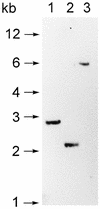Cloning and characterization of CAD1/AAF1, a gene from Candida albicans that induces adherence to endothelial cells after expression in Saccharomyces cerevisiae
- PMID: 9573092
- PMCID: PMC108166
- DOI: 10.1128/IAI.66.5.2078-2084.1998
Cloning and characterization of CAD1/AAF1, a gene from Candida albicans that induces adherence to endothelial cells after expression in Saccharomyces cerevisiae
Abstract
Adherence to the endothelial cell lining of the vasculature is probably a critical step in the egress of Candida albicans from the intravascular compartment. To identify potential adhesins that mediate the attachment of this organism to endothelial cells, a genomic library from C. albicans was used to transform a nonadherent strain of Saccharomyces cerevisiae. The population of transformed yeasts was enriched for highly adherent clones by repeated passages over endothelial cells. One clone which exhibited a fivefold increase in endothelial cell adherence, compared with S. cerevisiae transformed with vector alone, was identified. This organism also flocculated. The candidal DNA fragment within this adherent/flocculent organism was found to contain a single 1.8-kb open reading frame, which was designated CAD1. It was found to be identical to AAF1. The predicted protein encoded by CAD1/AAF1 contained features suggestive of a regulatory factor. Consistent with this finding, immunoelectron microscopy revealed that CAD1/AAF1 localized to the cytoplasm and nucleus but not the cell wall or plasma membrane of the transformed yeasts. Because yeasts transformed with CAD1/AAF1 both flocculated and exhibited increased endothelial cell adherence, the relationship between adherence and flocculation was examined. S. cerevisiae expressing either of two flocculation phenotypes, Flo1 or NewFlo, adhered to endothelial cells as avidly as did yeasts expressing CAD1/AAF1. Inhibition studies revealed that the flocculation phenotype induced by CAD1/AAF1 was similar to Flo1. Thus, CAD1/AAF1 probably encodes a regulatory protein that stimulates endothelial cell adherence in S. cerevisiae by inducing a flocculation phenotype. Whether CAD1/AAF1 contributes to the adherence of C. albicans to endothelial cells remains to be determined.
Figures




References
-
- Bidard F, Bony M, Blondin B, Dequin S, Barre P. The Saccharomyces cerevisiae FLO1 flocculation gene encodes for a cell surface protein. Yeast. 1995;11:809–822. - PubMed
-
- Christophe C, Minvielle-Sebastia L. Multipurpose vectors designed for the fast generation of N- or C-terminal epitope-tagged proteins. Yeast. 1994;10:105–112. - PubMed
-
- Cundell D R, Tuomanen E I. Receptor specificity of adherence of Streptococcus pneumoniae to human type-II pneumocytes and vascular endothelial cells in vitro. Microb Pathog. 1994;17:361–374. - PubMed
Publication types
MeSH terms
Substances
Grants and funding
LinkOut - more resources
Full Text Sources
Other Literature Sources
Molecular Biology Databases

